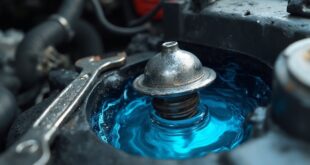If your car's thermostat is failing, you might notice an overheating engine, trouble reaching the normal operating temperature, or temperature fluctuations on the gauge. You could also experience inconsistent heat from the vents, indicating heater fluctuations. Finally, look out for possible leakages or steam coming from the engine, which could signal serious issues. Catching these signs early can save you from costly repairs, and there's more you can discover about this topic.
Overheating Engine
When your car's engine overheats, it can signal a serious problem, often linked to a failing thermostat. A stuck closed thermostat restricts coolant flow to the radiator, causing hot coolant to stagnate and raising the engine temperature dangerously high.
Ignoring this could lead to severe damage, like a blown head gasket. To troubleshoot, check your coolant levels, water pump, and radiator, as overheating may also stem from a clogged radiator.
Addressing these symptoms early on can save you from costly repairs and keep your vehicle running smoothly. Don't wait—act quickly to avoid bigger issues down the road.
Trouble Reaching Operating Temperature
If your car struggles to reach its normal operating temperature, a malfunctioning thermostat might be the culprit. When the thermostat is stuck open, coolant flows freely, preventing the engine from warming up properly. This can lead to decreased efficiency and increased fuel consumption.
| Symptoms | Causes | Effects |
|---|---|---|
| Low engine temperature | Stuck open thermostat | Poor fuel economy |
| Inefficient heating | Coolant flow issues | Engine wear |
| Increased emissions | Thermostat malfunction | Reduced performance |
Addressing this issue promptly can help maintain your vehicle's performance and longevity.
Temperature Fluctuations
Temperature fluctuations can signal a failing thermostat in your vehicle. If you notice your temperature gauge bouncing between hot and cold, it's a clear warning sign.
Sudden shifts in temperature readings can indicate that your thermostat isn't regulating coolant flow effectively. This erratic behavior can lead to inconsistent engine performance and may cause additional strain on your vehicle's systems.
Addressing these fluctuations promptly is essential to prevent further damage. Regularly monitoring the temperature gauge and inspecting your thermostat can help you catch issues early and guarantee your engine runs smoothly and efficiently.
Don't ignore these critical signals!
Heater Fluctuations
Experiencing heater fluctuations can be frustrating, especially during colder months when you rely on consistent warmth inside your vehicle.
If you notice inconsistent heat from your vents, it could signal a thermostat issue. A malfunctioning thermostat might disrupt coolant flow, leading to erratic temperatures that can make your drive uncomfortable.
You might find yourself adjusting the heater frequently just to maintain comfort. These irregularities not only affect your comfort but can also hint at underlying problems with the cooling system.
It's crucial to inspect the thermostat promptly to guarantee your heating system operates smoothly and efficiently.
Possible Leakages & Steam From Engine
Inconsistent heat from your vents can be a sign of more serious issues, particularly when it comes to potential leakages and steam from the engine.
If you notice coolant leaking or white steam escaping, it often means your engine's overheating. High pressure from hot coolant can find weak points in the system, leading to leaks.
Ignoring these signs can cause severe damage, like a blown head gasket. Regularly check for any visible leaks and monitor your engine temperature.
Catching these issues early can save you from costly repairs and keep your vehicle running smoothly.
Don't wait—address problems promptly!
Frequently Asked Questions
How Often Should I Replace My Car's Thermostat?
You should replace your car's thermostat every 10 to 15 years or if you notice any symptoms of issues. Regular maintenance checks can help you determine its condition and avoid unexpected failures.
Can a Bad Thermostat Trigger a Check Engine Light?
Yes, a bad thermostat can trigger your check engine light. It affects engine temperature regulation, which your vehicle's computer monitors. Address the issue promptly to avoid further complications and guarantee peak performance.
What Are the Costs of Thermostat Replacement?
Thermostat replacement costs typically range from $100 to $300, including parts and labor. Prices can vary based on your vehicle model and location, so it's best to get quotes from local mechanics for accurate estimates.
How Can I Test if My Thermostat Is Faulty?
To test your thermostat, monitor the engine temperature while driving. If it fluctuates or doesn't reach the normal range, it's likely faulty. You can also check for coolant flow issues when the engine is warm.
Will Driving With a Bad Thermostat Affect Fuel Economy?
Yes, driving with a bad thermostat will definitely affect your fuel economy. If the engine struggles to reach its ideal temperature, you'll see increased fuel consumption, leading to higher costs at the pump.
 Car Service Land Coupons for Oil change, Tires, Wheel alignment, Brakes, Maintenance
Car Service Land Coupons for Oil change, Tires, Wheel alignment, Brakes, Maintenance




